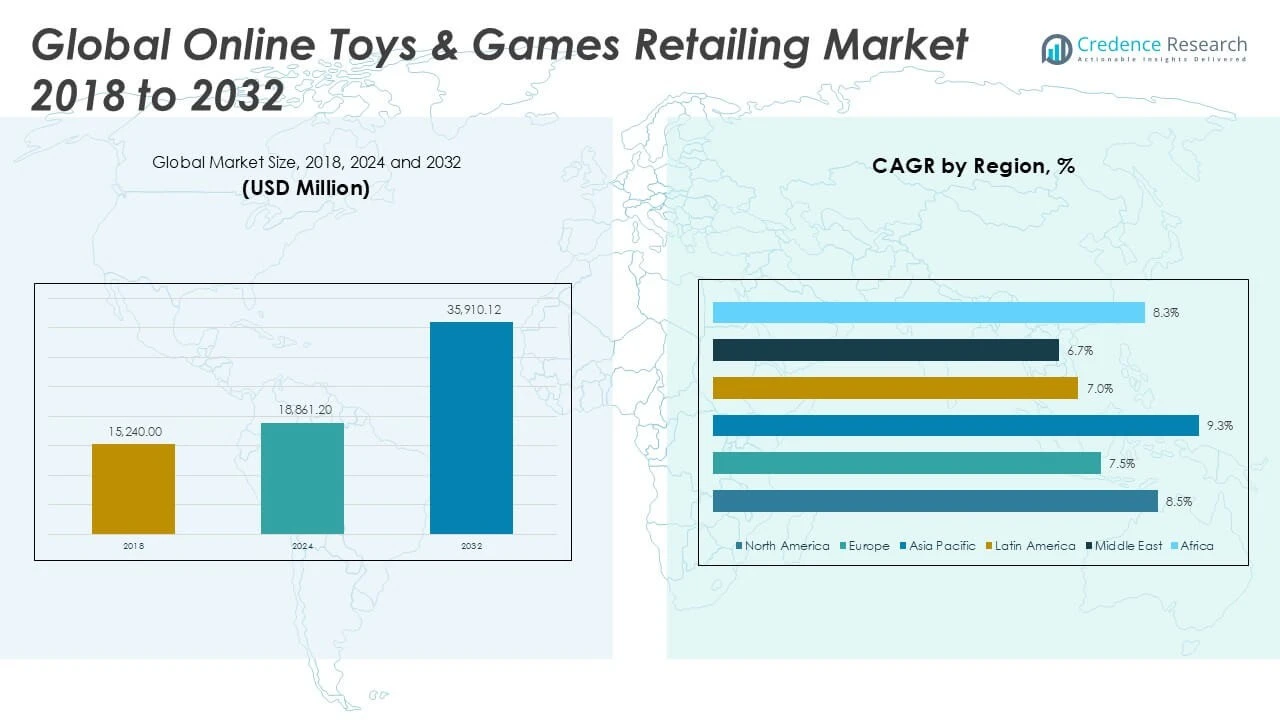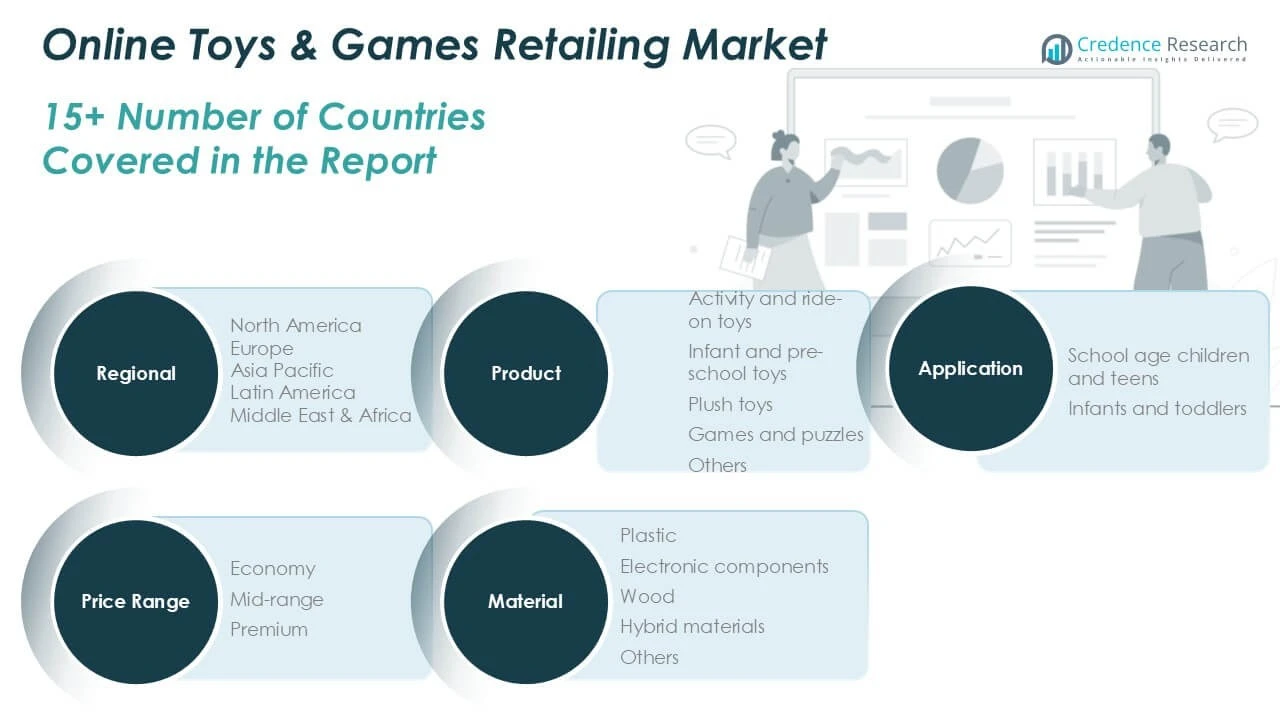CHAPTER NO. 1 : GENESIS OF THE MARKET
1.1 Market Prelude – Introduction & Scope
1.2 The Big Picture – Objectives & Vision
1.3 Strategic Edge – Unique Value Proposition
1.4 Stakeholder Compass – Key Beneficiaries
CHAPTER NO. 2 : EXECUTIVE LENS
2.1 Pulse of the Industry – Market Snapshot
2.2 Growth Arc – Revenue Projections (USD Million)
2.3. Premium Insights – Based on Primary Interviews
CHAPTER NO. 3 : ONLINE TOYS & GAMES RETAILING MARKET FORCES & INDUSTRY PULSE
3.1 Foundations of Change – Market Overview
3.2 Catalysts of Expansion – Key Market Drivers
3.2.1 Momentum Boosters – Growth Triggers
3.2.2 Innovation Fuel – Disruptive Technologies
3.3 Headwinds & Crosswinds – Market Restraints
3.3.1 Regulatory Tides – Compliance Challenges
3.3.2 Economic Frictions – Inflationary Pressures
3.4 Untapped Horizons – Growth Potential & Opportunities
3.5 Strategic Navigation – Industry Frameworks
3.5.1 Market Equilibrium – Porter’s Five Forces
3.5.2 Ecosystem Dynamics – Value Chain Analysis
3.5.3 Macro Forces – PESTEL Breakdown
3.6 Price Trend Analysis
3.6.1 Regional Price Trend
3.6.2 Price Trend by product
CHAPTER NO. 4 : KEY INVESTMENT EPICENTER
4.1 Regional Goldmines – High-Growth Geographies
4.2 Product Frontiers – Lucrative Product Categories
4.3 Application Sweet Spots – Emerging Demand Segments
CHAPTER NO. 5: REVENUE TRAJECTORY & WEALTH MAPPING
5.1 Momentum Metrics – Forecast & Growth Curves
5.2 Regional Revenue Footprint – Market Share Insights
5.3 Segmental Wealth Flow – Type & Application Revenue
CHAPTER NO. 6 : TRADE & COMMERCE ANALYSIS
6.1.Import Analysis by Region
6.1.1. Global Online Toys & Games Retailing Market Import Revenue By Region
6.2.Export Analysis by Region
6.2.1. Global Online Toys & Games Retailing Market Export Revenue By Region
CHAPTER NO. 7 : COMPETITION ANALYSIS
7.1.Company Market Share Analysis
7.1.1. Global Online Toys & Games Retailing Market: Company Market Share
7.2. Global Online Toys & Games Retailing Market Company Revenue Market Share
7.3.Strategic Developments
7.3.1.Acquisitions & Mergers
7.3.2. New Product Launch
7.3.3. Regional Expansion
7.4. Competitive Dashboard
7.5. Company Assessment Metrics, 2024
CHAPTER NO. 8 : ONLINE TOYS & GAMES RETAILING MARKET – BY PRODUCT SEGMENT ANALYSIS
8.1.Online Toys & Games Retailing Market Overview by Product Segment
8.1.1. Online Toys & Games Retailing Market Revenue Share By Product
8.2.Activity and ride-on toys
8.3. Infant and pre-school toys
8.4. Games and puzzles
8.5. Others
CHAPTER NO. 9 : ONLINE TOYS & GAMES RETAILING MARKET – BY APPLICATION SEGMENT ANALYSIS
9.1.Online Toys & Games Retailing Market Overview by Application Segment
9.1.1. Online Toys & Games Retailing Market Revenue Share By Application
9.2. School age children and teens
9.3. Infants and toddlers
CHAPTER NO. 10 :ONLINE TOYS & GAMES RETAILING MARKET – BY PRICE RANGE SEGMENT ANALYSIS
10.1.Online Toys & Games Retailing Market Overview by Price Range Segment
10.1.1. Online Toys & Games Retailing Market Revenue Share By Price Range
10.2. Economy
10.3. Mid-range
10.4. Premium
CHAPTER NO. 11 : ONLINE TOYS & GAMES RETAILING MARKET – BY MATERIAL SEGMENT ANALYSIS
11.1.Online Toys & Games Retailing Market Overview by Material Segment
11.1.1. Online Toys & Games Retailing Market Revenue Share By Material
11.2.Plastic
11.3. Electronic components
11.4. Wood
11.5. Hybrid materials
11.6. Others
CHAPTER NO. 12 : ONLINE TOYS & GAMES RETAILING MARKET – REGIONAL ANALYSIS
12.1.Online Toys & Games Retailing Market Overview by Region Segment
12.1.1. Global Online Toys & Games Retailing Market Revenue Share By Region
12.1.2.Regions
12.1.3.Global Online Toys & Games Retailing Market Revenue By Region
12.1.4.Product
12.1.5.Global Online Toys & Games Retailing Market Revenue By Product
12.1.6.Application
12.1.7. Global Online Toys & Games Retailing Market Revenue By Application
12.1.8. Price Range
12.1.9. Global Online Toys & Games Retailing Market Revenue By Price Range
12.1.10.Material
12.1.11. Global Online Toys & Games Retailing Market Revenue By Material
CHAPTER NO. 13 : NORTH AMERICA ONLINE TOYS & GAMES RETAILING MARKET – COUNTRY ANALYSIS
13.1. North America Online Toys & Games Retailing Market Overview by Country Segment
13.1.1.North America Online Toys & Games Retailing Market Revenue Share By Region
13.2.North America
13.2.1.North America Online Toys & Games Retailing Market Revenue By Country
13.2.2.Product
13.2.3.North America Online Toys & Games Retailing Market Revenue By Product
13.2.4.Application
13.2.5.North America Online Toys & Games Retailing Market Revenue By Application
13.2.6.Price Range
13.2.7.North America Online Toys & Games Retailing Market Revenue By Price Range
13.2.8.Material
13.2.9.North America Online Toys & Games Retailing Market Revenue By Material
13.3.U.S.
13.4.Canada
13.5.Mexico
CHAPTER NO. 14 : EUROPE ONLINE TOYS & GAMES RETAILING MARKET – COUNTRY ANALYSIS
14.1. Europe Online Toys & Games Retailing Market Overview by Country Segment
14.1.1. Europe Online Toys & Games Retailing Market Revenue Share By Region
14.2.Europe
14.2.1.Europe Online Toys & Games Retailing Market Revenue By Country
14.2.2.Product
14.2.3.Europe Online Toys & Games Retailing Market Revenue By Product
14.2.4.Application
14.2.5. Europe Online Toys & Games Retailing Market Revenue By Application
14.2.6. Price Range
14.2.7. Europe Online Toys & Games Retailing Market Revenue By Price Range
14.2.8.Material
14.2.9. Europe Online Toys & Games Retailing Market Revenue By Material
14.3.UK
14.4.France
14.5.Germany
14.6.Italy
14.7.Spain
14.8.Russia
14.9. Rest of Europe
CHAPTER NO. 15 : ASIA PACIFIC ONLINE TOYS & GAMES RETAILING MARKET – COUNTRY ANALYSIS
15.1.Asia Pacific Online Toys & Games Retailing Market Overview by Country Segment
15.1.1.Asia Pacific Online Toys & Games Retailing Market Revenue Share By Region
15.2.Asia Pacific
15.2.1. Asia Pacific Online Toys & Games Retailing Market Revenue By Country
15.2.2.Product
15.2.3.Asia Pacific Online Toys & Games Retailing Market Revenue By Product
15.2.4.Application
15.2.5.Asia Pacific Online Toys & Games Retailing Market Revenue By Application
15.2.6.Price Range
15.2.7.Asia Pacific Online Toys & Games Retailing Market Revenue By Price Range
15.2.8.Material
15.2.9.Asia Pacific Online Toys & Games Retailing Market Revenue By Material
15.3.China
15.4.Japan
15.5.South Korea
15.6.India
15.7.Australia
15.8.Southeast Asia
15.9. Rest of Asia Pacific
CHAPTER NO. 16 : LATIN AMERICA ONLINE TOYS & GAMES RETAILING MARKET – COUNTRY ANALYSIS
16.1. Latin America Online Toys & Games Retailing Market Overview by Country Segment
16.1.1.Latin America Online Toys & Games Retailing Market Revenue Share By Region
16.2. Latin America
16.2.1. Latin America Online Toys & Games Retailing Market Revenue By Country
16.2.2.Product
16.2.3. Latin America Online Toys & Games Retailing Market Revenue By Product
16.2.4.Application
16.2.5.Latin America Online Toys & Games Retailing Market Revenue By Application
16.2.6.Price Range
16.2.7.Latin America Online Toys & Games Retailing Market Revenue By Price Range
16.2.8.Material
16.2.9.Latin America Online Toys & Games Retailing Market Revenue By Material
16.3.Brazil
16.4.Argentina
16.5.Rest of Latin America
CHAPTER NO. 17 : MIDDLE EAST ONLINE TOYS & GAMES RETAILING MARKET – COUNTRY ANALYSIS
17.1.Middle East Online Toys & Games Retailing Market Overview by Country Segment
17.1.1.Middle East Online Toys & Games Retailing Market Revenue Share By Region
17.2.Middle East
17.2.1. Middle East Online Toys & Games Retailing Market Revenue By Country
17.2.2.Product
17.2.3.Middle East Online Toys & Games Retailing Market Revenue By Product
17.2.4.Application
17.2.5.Middle East Online Toys & Games Retailing Market Revenue By Application
17.2.6. Price Range
17.2.7.Middle East Online Toys & Games Retailing Market Revenue By Price Range
17.2.8. Material
17.2.9.Middle East Online Toys & Games Retailing Market Revenue By Material
17.3.GCC Countries
17.4. Israel
17.5. Turkey
17.6.Rest of Middle East
CHAPTER NO. 18 : AFRICA ONLINE TOYS & GAMES RETAILING MARKET – COUNTRY ANALYSIS
18.1. Africa Online Toys & Games Retailing Market Overview by Country Segment
18.1.1.Africa Online Toys & Games Retailing Market Revenue Share By Region
18.2. Africa
18.2.1.Africa Online Toys & Games Retailing Market Revenue By Country
18.2.2.Product
18.2.3.Africa Online Toys & Games Retailing Market Revenue By Product
18.2.4.Application
18.2.5. Africa Online Toys & Games Retailing Market Revenue By Application
18.2.6. Price Range
18.2.7. Africa Online Toys & Games Retailing Market Revenue By Price Range
18.2.8.Material
18.2.9. Africa Online Toys & Games Retailing Market Revenue By Material
18.3. South Africa
18.4.Egypt
18.5.Rest of Africa
CHAPTER NO. 19 : COMPANY PROFILES
19.1. Alpha Group Animation
19.1.1.Company Overview
19.1.2.Product Portfolio
19.1.3.Financial Overview
19.1.4.Recent Developments
19.1.5.Growth Strategy
19.1.6.SWOT Analysis
19.2. Amazon.com Inc.
19.3. BFL Group
19.4. Fat Brain Toys LLC
19.5. Fishpond Ltd.
19.6. Hasbro Inc.
19.7.Kidding Around Toys
19.8. Kohls Inc
19.9. Le Toys Van Inc
19.10. LEGO System AS
19.11. Mary Arnold Toys
19.12. Mattel Inc.
19.13. Nordstrom Inc.
19.14.Ravensburger AG





